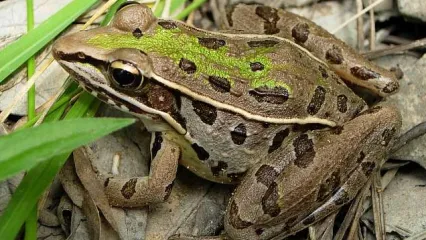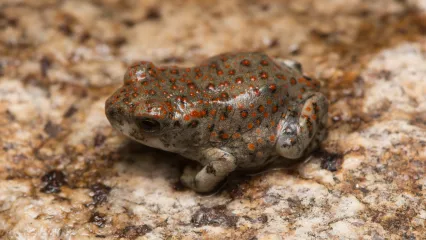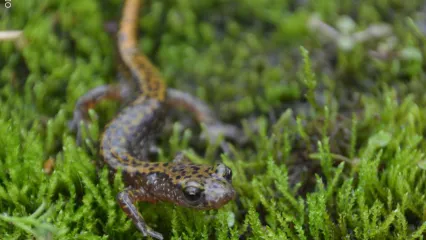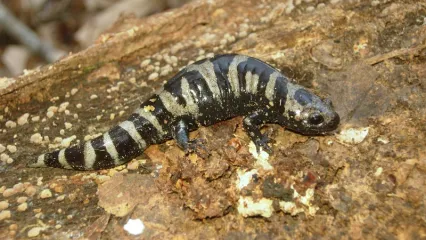
Description
Leopard frogs are a complex of medium-sized, slender frogs that are capable of very long jumps. Their name refers to the large leopard-like spots on the back. They are found throughout most of the U.S. and were once thought to be a single species. Detailed work beginning in the 1970s revealed that at least six species occur in the U.S., most of which can be distinguished by their mating calls and morphology. Two species of leopard frogs, the Coastal Plains leopard frog, and the plains leopard frog, occur in Oklahoma. The Coastal Plains leopard frog can be distinguished by several easily seen characters. In general, it has a long, pointed head, a slender body, and long back legs. The dorsum has relatively few large brown spots on a green or lighter brown background; frequently, one spot is present on top of the head. The tympanum (external eardrum) is dark brown with a small light spot in the center. Raised golden dorsolateral ridges extend from behind the eyes to the groin. This ridge is unbroken in Coastal Plains leopard frogs, whereas in other leopard frogs, the ridge may be broken and offset near the groin.
Tadpoles of the Coastal Plains leopard frogs can reach 2 to 2.5 inches before transforming into froglets. The bodies are brown with fine darker brown mottling. The tail and tail fins are lighter brown with more distinct mottling. They generally remain as tadpoles for at least two to three months before metamorphosis. Coastal Plains leopard frogs have complex calls. Vocalizations are often difficult to study because the frogs are very wary and quickly flee when approached.
The call has distinct sounds, including a low chuckling and a creaking sound as if rubbing one’s finger over a balloon. On days following rainfall in early spring, males often call throughout the day as well as night.
Size
Males are generally much smaller than females in this species. Large females may reach 4 inches in length, whereas males typically range in size from 2.5 to 3 inches.
Habitat
In Oklahoma, Coastal Plains leopard frogs occur throughout most of the eastern two-thirds of the state. Within the U.S., they occur throughout the southeast, ranging as far north as Kansas, Missouri, and Illinois to New York.
Life Cycle
Coastal Plains leopard frogs are found in a variety of habitats, including shorelines of temporary ponds, woodland pools, wet meadows, and lake edges with heavy vegetation. In many parts of its range, including Oklahoma, breeding occurs primarily at two times of the year, in early spring from late February to March, and in late summer or early fall, usually in September. Sporadic breeding can occur in nearly any month of the year, depending on rainfall and other suitable weather conditions. Males congregate at the breeding sites and call to attract females; the call is complex, consisting of various chuckling and low snoring sounds. Circular egg masses, consisting of several thousand eggs are placed in shallow water; if further rains do not occur, many egg masses dry up before they have time to hatch. During the early spring breeding, many pairs deposit their eggs communally in the same small area; as many as 150 masses may be found piled together. Because the eggs are black, one hypothesis is that the eggs gain a thermal advantage because the dark color absorbs heat. Hatching occurs within 3 to 4 days depending on temperature. Tadpoles generally require 2 to 3 months to reach metamorphosis.
How To Observe
Coastal Plains leopard frogs are one of the easiest Oklahoma frogs to observe. They are common around most ponds and marshy areas. During warmer parts of the year, they remain around pond shorelines even when not breeding. They can easily be found by walking slowly along the edge of a pond and watching for them to jump into the water. Their cryptic coloration makes them somewhat difficult to see when they remain motionless. They are very fast and not easily caught once located.
(This profile was created by Dr. Laurie Vitt as part of a partnership between the Wildlife Department and the Sam Noble Oklahoma Museum of Natural History. It was funded as part of a larger State Wildlife Grant to survey and inventory amphibians and reptiles of the Wildlife Management Areas of Oklahoma: T-35-P-1.)


